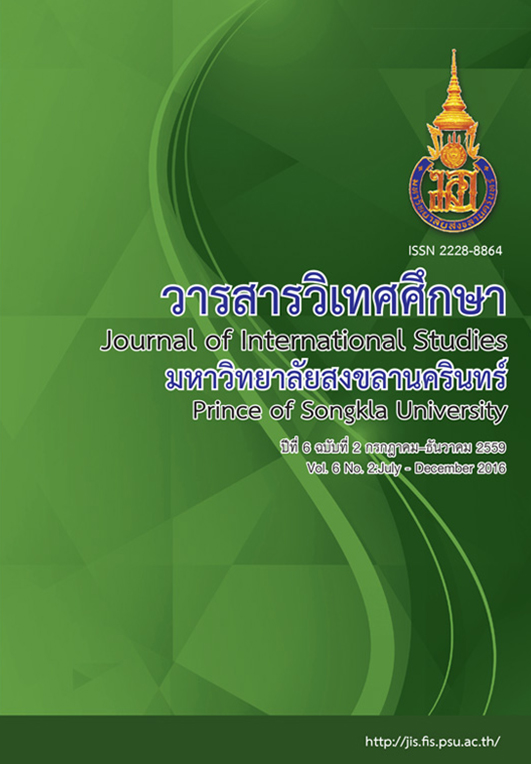National Culture and the Challenges in Managing Strategic Changes: A Case Study of General Motors and Daewoo
Main Article Content
Abstract
This study has critically reviewed literatures that are related to Mergers & Acquisitions (M&A) and Managing Strategic Changes (MSC) which are vital knowledge for global companies in order to successfully penetrate and expand their operations worldwide. The aims of this study are to show how GM (General Motors), a leading car manufacturer in the United States, successfully merged with Daewoo, a leading car manufacturer in South Korea, and how they were able to manage changes strategically. The actual company’s case study was used which obviously occurred in order to enhance better comprehension. General Motors Company is exemplified as one of the achieved outcomes of Mergers & Acquisitions in this study . Data was collected from related literatures, theories, and were analyzed respectively. The finding was very interesting, showing the heterogeneity of national culture among two nations influence Mergers & Acquisitions actions therefore understanding national culture is significant to managing changes effectively .
Article Details
Statements and opinions expressed in articles herein are those of the authors and do not necessarily reflect the position of the editors or publisher.
Article, information, text, image, etc. which are published in Journal of International Studies, belong to Journal of International Studies. If anybody or any organization would like to use part or whole of them, they must receive written permission from Journal of International Studies before usage.
References
Akinbuli, S., (2012). 'Critical Analysis of the Effect of mergers and acquisitions on corporate growth and profitability', Global Conference On Business & Finance Proceedings, 7, 1, pp. 684-697, Business Source Complete, EBSCOhost, Accessed [30 March 2012].
Christos, A. (2012). Managing Mergers & Acquisitions. Lecture 4, 27 February 2012, p.8.
Cox, T, JR.( 2001). Creating the Multicultural Organization. A Strategy for Capturing the Power of Diversity. Sanfrancisco: Jossey-Bass.
Coyle, B. (2000). Mergers and Acquisitions, CIB Publishing, c/o The Chartered Institute of Bankers, Kent, United Kingdom.
Ferrell, O.C. & Hartline, M.D. (2011). Marketing Strategy, 5th Edition, South-Western Cengage Learning
Fiss, P. C.& Zajac, E. (2006). The symbolic management of strategic change: Sensegiving via framing and decoupling. Academy of Management Journal, 49, pp. 1173– 1193.
Froeses,F.J. (2010). Success and Failure in Managing Foreign Acquisitions in South Korea and Japan: Lessons From Renault, General Motors, and DaimlerChrysler. Global Business and Organisational Excellence. John Wiley & Sons, Inc.
General Motors Company. (2012). Available from: www.gm.com. Accessed [31 March 2012].
Gioia, D. A., & Chittipeddi, K. (1991). Sensemaking and sensegiving in strategic change initiation. Strategic Management Journal, 12: 433–448.
Gioia, D. A.& Thomas, J. B., Clark, S. M., & Chittipeddi, K. 1994. Symbolism and strategic change in academia—The dynamics of sensemaking and influence.Organization Science, 5,pp. 363–383.
Greenwood, R., & Hinings, C. R. (1988). Organizational design types, tracks and the dynamics of strategic change. Organization Science, 9, pp. 293–316.
Hall, E.T. (1960). ‘The silent lanaguge in overseas business’in Harvard Business Review, May-June.
Hofstede, G. (2012). Organizational culture. Available from: http://geert-hofstede.com/organisational-culture.html. Accessed [31 March 2012].
Jackson, T. (1995). Cross-Cultural Management. Oxford: Butterworth-Heinemann Ltd.
Johnson et al. (2008). Exploring Corporate Strategy, 8th ed. Essex: Prentice Hall.
No author. (2009). KPMG Global M&A survey 2009. Contemporary Issues in Management class.
Labianca, G. & Gray, B., & Brass, D. J.(2000. A grounded model of organizational schema change during empowerment. Organization Science, 11: 235–257.
Lambkin et al.., 2008. "Rebranding in the banking industry following mergers and acquisitions",
International Journal of Bank Marketing, Vol. 26 Iss: 5, pp.328 – 352.
Lecture slide 22 presented by Dr. Christos. Lecture 4: Managing Mergers & Acquisitions. 27 February 2012.
Moon et al. (2004). 'DAEWOO: GM'S HOT NEW ENGINE', Businessweek, 3910, pp. 52-53, Business Source Complete, EBSCOhost, viewed 1 April 2012.
Mullins, L. (2010), Management and Organisational Behaviour, (9th Ed), Essex, Prentice Hall. Chapters 10, 11, 12. (E)
Pandy, I.M. (2000). Financial Management, Vikas Publishing House Pvt. Ltd.
Pawaskkar, V.( 2001). Effect of Mergers on Corporate Performance in India. Vikalpa, 26 (1), pp. 19-32.
Rajagopalan, N., & Spreitzer, G. M. (1997). Toward a theory of strategic change: A multi-lens perspective and integrative framework. Academy of Management Review, 22, pp. 48–79.
Sadri, G, & Bowen, R (2011). 'Meeting Employee requirements: Maslow's hierarchy of needs is still a reliable guide to motivating staff', Industrial Engineer: IE, 43, 10, pp. 44-48, Business Source Complete, EBSCOhost, viewed 1 April 2012.
Treece, JB. (2008). 'After scramble for an Asia strategy, GM thinks Daewoo is the answer', Automotive News, 83, 6325A, pp. 202, Business Source Complete, EBSCOhost, viewed 31 March 2012.
Tushman, M. L., & Romanelli, E. (1985). Organizational evolution: A metamorphosis model of convergence and reorientation. In L. L. Cummings & B. M. Staw (Eds.), Research in organizational behavior, vol. 1, pp. 171–222. Greenwich, CT: JAI.
Wang, L. H., & Zajac, E. J. (2007). Alliance or acquisition? A dyadic perspective on interfirm resource combinations. Strategic Management Journal, 28, pp. 1291–1317.


